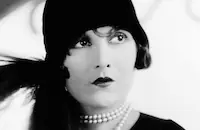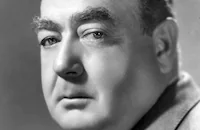Paramount on Parade
Cast & Crew
Dorothy Arzner
Iris Adrian
Richard Arlen
Jean Arthur
Mischa Auer
William Austin
Film Details
Technical Specs

Synopsis
SHOWGIRLS ON PARADE: a Technicolor spectacle of chorus girls and ushers to the tune of the theme song. TITLES: Dissolves including studio scenes and toe-dancing by Mitzi Mayfair. INTRODUCTION: Jack Oakie, Skeets Gallagher, and Leon Errol open with "We're the Masters of Ceremony." LOVE TIME: Charles Rogers and Lillian Roth with a boy-girl chorus on a cuckoo-clock set sing "Any Time's the Time To Fall in Love." MURDER WILL OUT: a travesty on detective mysteries with William Powell as Philo Vance, Clive Brook as Sherlock Holmes, Eugene Pallette as Sergeant Heath, Warner Oland as Dr. Fu Manchu, and Jack Oakie as the victim. ORIGIN OF THE APACHE: a slapstick sketch wth Maurice Chevalier and Evelyn Brent dancing in a bedroom, directed by Lubitsch. SONG OF THE GONDOLIER: Italian tenor Nino Martini appears in a Technicolor sketch singing "Torna a Sorrento." IN A HOSPITAL: a comedy sketch with Leon Errol, Helen Kane, and David Newell. IN A GIRL'S GYM: Jack Oakie as the instructor and Zelma O'Neal as the jealous sweetheart, including the song "I'm in Training for You." THE TOREADOR: Harry Green as the Toreador and Kay Francis as Carmen in a comic sketch with the Marion Morgan dancers, with Green singing "I'm Isadore, the Toreador." THE MONTMARTRE GIRL: Ruth Chatterton in a Paris cafe sings "My Marine" to a quartette including Stuart Erwin, Stanley Smith, and Fredric March. PARK IN PARIS: Chevalier as a Paris gendarme patrols a park singing "All I Want Is Just One Girl." MITZI HERSELF: Mitzi Green sings the Chevalier song as Charlie Mack of Moran and Mack would sing it, then as Chevalier sings it. THE SCHOOLROOM: Helen Kane is the teacher in a modernistic schoolroom singing "What Did Cleopatra Say?" to the children, who answer "Boop Boopa Doop." THE GALLOWS SONG:Skeets Gallagher demands that Dennis King sing, before he is hanged, Mana-Zucca's "Nichavo," a Russian love song--all in Technicolor. DANCE MAD: Nancy Carroll, with chorus support and Abe Lyman's band, does "Dancing To Save Your Sole." DREAM GIRL: a sentimental interlude in Technicolor with Richard Arlen, Jean Arthur, Mary Brian, Gary Cooper, James Hall, Fay Wray, among others, featuring "Let Us Drink to the Girl of My Dreams." THE REDHEAD: Clara Bow appears with Jack Oakie, Skeets Gallagher, and a chorus of 42 sailors in "I'm True to the Navy Now." IMPULSES: George Bancroft, at a social function with Kay Francis, William Austin, and others, demonstrates contrasts in social behavior. THE RAINBOW REVELS: Chevalier and a girls' chorus appear as Paris chimney sweeps in the Technicolor finale, singing "Sweeping the Clouds Away."

Directors

Dorothy Arzner
Otto Brower

Edmund Goulding
Victor Heerman
Edwin H. Knopf
Rowland V. Lee

Ernst Lubitsch
Lothar Mendes

Victor Schertzinger
Edward Sutherland
Frank Tuttle
Cast

Iris Adrian

Richard Arlen

Jean Arthur

Mischa Auer
William Austin

George Bancroft

Clara Bow

Evelyn Brent

Mary Brian
Clive Brook

Virginia Bruce
Nancy Carroll

Ruth Chatterton

Maurice Chevalier

Gary Cooper

Cecil Cunningham

Leon Errol

Stuart Erwin
Henry Fink

Kay Francis
Skeets Gallagher

Edmund Goulding
Harry Green

Mitzi Green
Robert Greig

Phillips Holmes
Helen Kaine

Dennis King
Abe Lyman And His Band

Fredric March
Nino Martini
Mitzi Mayfair
Marion Morgan Dancers
David Newell

Jack Oakie

Warner Oland
Zelma O'neal

Eugene Pallette
Joan Peers
Jack Pennick

William Powell
Charles "buddy" Rogers

Lillian Roth
Rolfe Sedan
Stanley Smith

Fay Wray
Lucille Miller
Lorena Carr
Louise Pimm
Prudence Sutton
Rosalie Martin
Dolorez Blair
Mozil Britton
Charlene Burt
Crew
Abel Baer
David Bennett
Sam Coslow
Ernesto De Curtis
Dave Dreyer
Raymond B. Egan
Harry Fischbeck
David Franklin
L. Wolfe Gilbert
Elsie Janis
Elsie Janis
Helen Jerome
Jack King
Ballard Macdonald
Mana-zucca
Victor Milner
Leo Robin
John Wenger
Richard A. Whiting

Film Details
Technical Specs

Articles
Fay Wray (1907-2004)
She was born Vina Fay Wray, in Cardston, Alberta, Canada on September 15, 1907. Her family relocated to Arizona when she was still a toddler so her father could find employment. When her parents divorced, her mother sent her to Hollywood when Fay's eldest sister died in the influenza epidemic of 1918. The reasoning was that Southern California offered a healthier climate for the young, frail Wray.
She attended Hollywood High School, where she took some classes in drama. After she graduated, she applied to the Hal Roach studio and was given a six-month contract where she appeared in two-reel Westerns (25 minutes in length), and played opposite Stan Laurel in his pre-Oliver Hardy days.
She landed her first big role, as Mitzi Schrammell, in Erich von Stroheim's beautifully mounted silent The Wedding March (1928). It made Wray a star. She then starred in some excellent films: The Four Feathers (1929), the early Gary Cooper Western The Texan (1930), and one of Ronald Coleman's first starring roles The Unholy Garden (1931), all of which were big hits of the day.
For whatever reason, Wray soon found herself in a string of thrillers that made her one of the great screamers in Hollywood history. The titles say it all: Doctor X, The Most Dangerous Game (both 1932), Mystery of the Wax Museum, The Vampire Bat (both 1933) and, of course her most famous role, that of Ann Darrow, who tempts cinema's most famous ape in the unforgettable King Kong (also 1933).
Wray did prove herself quite capable in genre outside of the horror game, the best of which were Shanghai Madness with Spencer Tracy; The Bowery (both 1933), a tough pre-Hays Code drama opposite George Raft; and the brutal Viva Villa (1934), with Wallace Beery about the famed Mexican bandit. Yet curiously, the quality of her scripts began to tank, and she eventually found herself acting in such mediocre fare as Come Out of the Pantry (1935), and They Met in a Taxi (1936).
With her roles becoming increasingly routine, the last of which was the forgettable comedy Not a Ladies Man (1942), she decided to trade acting for domesticity and married Robert Riskin, who won two Best Screenplay Oscars® for the Frank Capra comedies It Happened One Night (1934) and Mr. Deeds Goes to Town (1936). When Riskin died in 1955, Wray found herself working to keep busy and support her three children. She landed supporting parts for films like The Cobweb (1955), Hell on Frisco Bay (1956) and Tammy and the Bachelor (1957). She also found work in television on such popular programs as Perry Mason and Wagon Train before she retired from acting all together in the mid-'60s.
To her credit, Wray did remain reasonably active after her retirement. She published her autobiography, On The Other Hand in 1989 and was attending many film festivals that honored her contribution to film, most notably in January 2003, when, at 95 years of age, she accepted in person her "Legend in Film" Award at the Palm Beach International Film Festival. Wray is survived by a son, Robert Riskin Jr.; two daughters, Susan and Victoria; and two grandchildren.
by Michael T. Toole

Fay Wray (1907-2004)
Quotes
Trivia
Jeanette MacDonald's musical number was cut from the picture before it was released. Her number only exists in the Spanish version of the film.
Notes
For information on several foreign-language versions of Paramount on Parade, please consult the entry for Galas de la Paramount.














